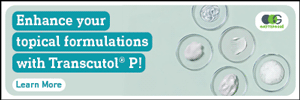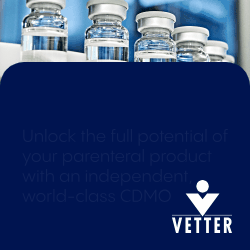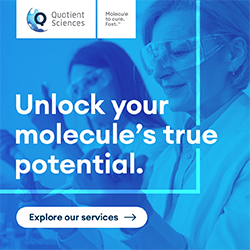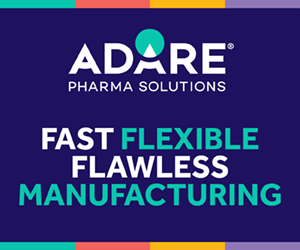Drug Delivery
PharmNovo announces CTA submission for lead candidate PN6047, a next generation selective Delta Opioid Receptor Agonist (DORA) for treatment of neuropathic pain
PN6047 is a first-in-class small molecule that selectively activates the delta opioid receptor (DOR), avoiding interaction with the mu opioid receptor that is the basis…
Aptamer Group Identifies Novel Target to Enable Cell-Specific Gene Therapy for Liver Fibrosis
Aptamer unveils novel biomarker for targeted liver fibrosis therapy Optimer breakthrough targets liver scarring cells, positioning Aptamer in $20bn fibrosis market Aptamer Group plc today…
Artelo Biosciences Announces Positive First-in-Human Data for ART26.12, a Novel Non-Opioid Treatment Candidate for Persistent Pain
First Orally Active Fatty Acid Binding Protein 5 Inhibitor Evaluated in Humans First-in-Class Approach Targets Unmet Need in Multibillion-Dollar Pain Management Market SOLANA BEACH, Calif.,…
Simtra BioPharma Solutions Expands Halle/Westfalen, Germany Facility with the Addition of a New Production Building
HALLE (WESTFALEN), Germany, Simtra BioPharma Solutions announced today that it completed the construction of its new production manufacturing building at its campus in Halle, Germany. As…
Vetter Marks the Start of New Clinical Site Construction with Groundbreaking Ceremony
Pharmaceutical service provider expands its footprint in the greater Chicago area Production site expected to be fully operational by the end of 2029 Modern site…
Allarity Therapeutics Announces Dosing of Second Patient in New Phase 2 Trial of Stenoparib in Advanced Ovarian Cancer
TARPON SPRINGS, Fla., Allarity Therapeutics, Inc. (NASDAQ: ALLR), a Phase 2 clinical-stage pharmaceutical company dedicated to developing stenoparib—a differentiated, dual PARP and WNT pathway inhibitor…
Opus Genetics Announces VEGA-3 Phase 3 Trial Met its Primary Endpoint for Phentolamine Ophthalmic Solution 0.75% for the Treatment of Presbyopia
RESEARCH TRIANGLE PARK, N.C., Opus Genetics, Inc. (Nasdaq: IRD), a clinical-stage biopharmaceutical company developing gene therapies for the treatment of inherited retinal diseases (IRDs) and…
Positive Top Line Results from Confirmatory Efficacy Study for Proposed Biosimilar to Xolair (omalizumab)
REYKJAVIK, Iceland and PISCATAWAY, N.J. and LONDON, Alvotech (NASDAQ: ALVO), a global biotech company specializing in the development and manufacturing of biosimilar medicines for patients…
Sever Pharma Solutions Announces Commercialization of New Aseptic Fill and Finish Line for Prefilled Syringes in Malmö, Sweden
MALMÖ, SWEDEN– Sever Pharma Solutions, a leading CDMO, proudly announces the commercialization of its new state-of-the-art aseptic fill and finish line for prefilled syringes, capable…
Plus Therapeutics Announces FDA Clearance of its Investigational New Drug Application using REYOBIQTM for the Treatment of Childhood Brain Cancer
HOUSTON, Plus Therapeutics, Inc. (Nasdaq: PSTV), a clinical-stage pharmaceutical company developing targeted radiotherapeutics with advanced platform technologies for central nervous system (CNS) cancers, today announced…
Longeveron Announces Completion of Enrollment of Pivotal Phase 2b Clinical Trial Evaluating Laromestrocel as a Treatment for Hypoplastic Left Heart Syndrome (HLHS)
Top-line trial results are anticipated in the third quarter of 2026, after the final follow-up at 12-months Laromestrocel Biological License Application (BLA) submission for…
Neurona Doses First Patient in Phase 1/2 Trial of NRTX-1001 Cell Therapy in Adults with Drug-Resistant, Bilateral Mesial Temporal Lobe Epilepsy (MTLE)
- First patient received bilateral administration of NRTX-1001; no significant surgical complications or adverse events reported to date - - Trial funded by a…
BASF strengthens its commitment to the biopharma and pharmaceutical ingredients industries through a new investment in North America
New Good Manufacturing Practice (GMP) Solution Center in Wyandotte, Michigan expands BASF’s existing network of poloxamers sites Production capabilities are unique to industry and enable…
Veranova Devens Site Breaks Ground on ADC Facility Expansion
Devens, MA, USA — Government officials, industry leaders, and local business representatives gathered yesterday to mark the groundbreaking of Veranova’s latest expansion at its Devens,…
Symbiotic.blue Launches to Combine Oxford and Cambridge Scientific Brain Power with Bioentrepreneurial Leadership to Reinvent AI Drug Discovery
Symbiotic.blue, the UK’s newest Techbio company has launched to innovate a next-generation artificial intelligence-driven drug discovery (AIDD) platform by combining the power of generative AI…
Sanner has officially launched manufacturing operations in Greensboro, North Carolina
The new facility is dedicated to producing critical injection-molded components for medical devices and pharmaceutical packaging, as well as desiccant solutions. This expansion reflects Sanner’s…
Kindeva joins forces with Rocket Science Health to pioneer new Intranasal Delivery Platform
Kindeva, a global CDMO and drug delivery expert, and Rocket Science Health (RSH), a Canadian technology healthcare company, have joined forces to find partners to…
Northstrive Biosciences Announces Initiation of Phase II of Collaboration to Develop AI Powered Therapies for Obesity and Cardiometabolic Disease
Northstrive Biosciences and Yuva Biosciences previously announced a collaboration leveraging MitoNova™, YuvaBio’s proprietary mitochondrial science-focused artificial intelligence platform, to discover and develop novel pharmaceutical treatments for obesity, type 2 diabetes and other cardiometabolic conditions.
Tiziana Life Sciences Expands Phase 2 Clinical Trial of Intranasal Foralumab With Commencement of First Patient Dosing
Tiziana Life Sciences, Ltd recently announces that dosing has commenced at the prestigious Weill Cornell Medicine Multiple Sclerosis Center in New York City, in its ongoing…
SPECIAL FEATURE- Outsourcing Formulation Development & Manufacturing: CDMOs Are Making Their Supply Chains More Resilient & Secure
Contributor Cindy H. Dubin speaks with many CDMO professionals to get their insights and perspectives on the current state of the industry.
What are Drug Delivery Systems?
Drug delivery systems are engineered technologies for the targeted delivery and/or controlled release of therapeutic agents. The practice of drug delivery has changed significantly in the past few decades and even greater changes are anticipated in the near future. Drug delivery includes but is not limited to oral delivery, gene/cell delivery, topical/transdermal delivery, inhalation deliver, parenteral delivery, respiratory delivery, capsules, particle design technology, buccal delivery, etc.
The Evolution of Drug Delivery Systems
Drug delivery systems have greatly evolved over the past 6 decades. In the past 12 years specifically, there have been huge advancements in drug delivery technology. For instance, advanced medication delivery systems, such as transdermal patches, are able to deliver a drug more selectively to a specific site, which frequently leads to easier, more accurate, and less dosing overall. Devices such as these can also lead to a drug absorption that is more consistent with the site and mechanism of action. There are other drug delivery systems used in both medical and homecare settings that were developed because of various patient needs and researchers continue to develop new methods.
Drug Delivery System Market Size
The pharmaceutical drug delivery market size is studied on the basis of route of administration, application, and region to provide a detailed assessment of the market. On the basis of route of administration, it is segmented into oral delivery, pulmonary delivery, injectable delivery, nasal delivery, ocular delivery, topical delivery, and others.
The estimated global market size of drug delivery products was $1.4 trillion in 2020. Unfortunately, 40% of marketed drugs and 90% of pipeline drugs (mostly small molecules) are poorly soluble in water, which makes parenteral, topical, and oral delivery difficult or impossible. In relation, poor solubility often leads to low drug efficacy. Add in the fact that many other hurdles exist in the form of drug loading, stability, controlled release, toxicity, and absorption – it’s not hard to understand the difficulties in bringing new drug products to market. Additionally, biopharmaceuticals (proteins, peptides, nucleic acids, etc) and combination drug products possess many of these same problematic obstacles that affect efficacy. These challenges, coupled with the complexity and diversity of new pharmaceuticals, have fueled the development of a novel drug delivery platforms that overcome a great many bioavailability and delivery obstacles. By leveraging these platforms, pharmaceutical and biopharmaceutical companies can improve dosing accuracy, efficacy, and reproducibility in their drug discovery and drug delivery research.
Drug Delivery System Demand
The demand for pharmaceutical products worldwide is only going to increase in the coming years, as old and emerging diseases continue to threaten the well-being of people globally. Drug discovery efforts are expected to intensify, generating a large variety of active compounds with vastly different structures and properties. However, it is well known that despite tremendous output of the drug discovery process, the success rate of a candidate compound becoming an approved drug product is extremely low. The majority of candidate compounds are discarded due to various hurdles in formulation and preclinical testing (such as issues with solubility, stability, manufacturing, storage, and bioavailability) before even entering into clinical studies. Therefore, advances in formulation and drug delivery, especially the development of new and versatile biomaterial platforms as effective excipients, may salvage many “difficult,” otherwise triaged, drug compounds, and significantly enhance their chance of becoming viable products. Furthermore, breakthroughs in biomaterial platform technologies will also facilitate life cycle management of existing APIs through reformulation, repurposing of existing APIs for new indications, and development of combination products consisting of multiple APIs.










